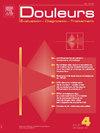Intérêt thérapeutique des patchs de capsaïcine 8 % dans la prise en charge du syndrome douloureux régional complexe : une analyse rétrospective
引用次数: 0
Abstract
Introduction
Le traitement antalgique du syndrome douloureux régional complexe (SDRC) peut s’avérer fastidieux et nécessite une approche multimodale. Les études concernant l’efficacité de la capsaïcine dans le traitement des douleurs neuropathiques sont nombreuses, mais peu d’études sont disponibles concernant son efficacité dans le traitement du syndrome douloureux régional complexe. Cette étude vise à évaluer l’amélioration de la symptomatologie douloureuse ressentie par les patients atteints du syndrome douloureux régional complexe et traités par patch de capsaïcine 8 %, et compare ensuite l’amélioration de la symptomatologie et la durée du soulagement ressentie au sein d’un groupe SDRC et d’un groupe non SDRC.
Matériels et méthodes
Nous avons analysé rétrospectivement le dossier médical de 4371 patients ayant consulté la clinique de la douleur de juin 2011 à décembre 2023. Nous avons étudié le dossier médical de 73 patients ayant bénéficié d’un traitement par patch de capsaïcine 8 %. Au total, 68 patients ont été inclus dans l’étude, dont 26 étaient atteints du SDRC (groupe SDRC) et 42 de douleurs neuropathiques (groupe non SDRC).
Résultats
Dans le groupe SDRC (n = 26), 69,2 % (n = 18) des patients décrivent une amélioration de leur symptomatologie et 57,7 % (n = 15) rapportent une réduction d’au moins 50 % de la douleur. Il n’y a pas de différence significative entre les groupes SDRC et non SDRC en termes d’amélioration de la symptomatologie (p = 0,8233) ni en termes de réduction de la douleur (p = 0,7193). La durée moyenne de soulagement est de 30 [0,5–60] jours dans le groupe SDRC et de 12,5 [0–60] jours dans le groupe non SDRC.
Conclusion
Face au défi que représente la prise en charge du syndrome douloureux régional complexe, la place de la capsaïcine dans l’arsenal thérapeutique semble se confirmer. Son effet notable et rapide sur le soulagement de l’allodynie, son action prolongée ainsi que sa sécurité d’emploi, en une application, rendent son utilisation sûre et pratique.
Introduction
Analgesic treatment of complex regional pain syndrome (CRPS) can be tedious and requires a multimodal approach. Studies concerning the efficacy of capsaicin in the treatment of neuropathic pain are numerous, but few studies are available concerning its efficacy in the treatment of complex regional pain syndrome. The aim of this study was to assess the improvement in pain symptomatology experienced by complex regional pain syndrome patients treated with capsaicin 8% patch, and then to compare the improvement in symptomatology and duration of relief experienced within a CRPS group and a non-CRPS group.
Materials and methods
We retrospectively analyzed the medical records of 4371 patients who consulted the pain clinic from June 2011 to December 2023. We studied the medical records of 73 patients who had received treatment with an 8% capsaicin patch. In all, 68 patients were included in the study, of whom 26 had complex regional pain syndrome (CRPS group) and 42 had neuropathic pain (non-CRPS group).
Results
In the CRPS group (n = 26), 69.2% (n = 18) of patients described an improvement in symptomatology, and 57.7% (n = 15) reported at least a 50% reduction in pain. There was no significant difference between CRPS and non-CRPS groups in terms of symptomatology improvement (P = 0.8233) or pain reduction (P = 0.7193). The mean duration of relief was 30 [0.5–60] days in the CRPS group and 12.5 [0–60] days in the non-CRPS group.
Conclusion
Faced with the challenge of managing complex regional pain syndrome, capsaicin's place in the therapeutic arsenal seems to be confirmed. Its significant and rapid effect in relieving allodynia, its prolonged action and its safety in a single application make its use safe and practical.
辣椒素贴片在治疗复杂区域疼痛综合征中的疗效8%:回顾性分析
复杂区域疼痛综合征(CRDS)的镇痛治疗可能是乏味的,需要多模式的方法。关于辣椒素治疗神经性疼痛的有效性的研究很多,但关于其治疗复杂区域疼痛综合征的有效性的研究很少。本研究旨在评估改善疼痛综合症患者所感受到的痛苦症状复杂区域条约和贴片的8%的辣椒素,然后比较改善症状和感受时间一口气SDRC组和非SDRC群内。材料和方法我们回顾了2011年6月至2023年12月期间在疼痛诊所就诊的4371名患者的医疗记录。我们研究了73例接受8%辣椒素贴片治疗的患者的病史。共有68名患者参与了这项研究,其中26人患有RSDC (RSDC组),42人患有神经性疼痛(非RSDC组)。结果在CRD组(n = 26)中,69.2% (n = 18)的患者报告症状有所改善,57.7% (n = 15)的患者报告疼痛减轻至少50%。RDC组和非RDC组在症状改善(p = 0.8233)和疼痛减轻(p = 0.7193)方面没有显著差异。RSDC组的平均缓解时间为30[0.5 - 60]天,非RSDC组为12.5[0 - 60]天。结论:面对管理复杂区域疼痛综合征的挑战,辣椒素在治疗武器库中的地位似乎得到了证实。其显著和快速的效果,缓解异位动力学,其长期的作用和使用的安全性,在一个应用程序,使其使用安全和方便。复杂区域疼痛综合征(CRPS)的镇痛治疗可能是无聊的,需要多模式的方法。关于辣椒素在治疗神经性疼痛方面的有效性的研究很多,但关于辣椒素在治疗复杂的局部疼痛综合征方面的有效性的研究很少。本研究的目的是评估接受辣椒素8%贴片治疗的复杂区域疼痛综合征患者的疼痛症状改善,然后比较CRPS组和非CRPS组的症状改善和缓解持续时间。我们回顾性分析了2011年6月至2023年12月期间访问疼痛诊所的4371名患者的医疗记录。我们研究了73名接受8%辣椒素贴片治疗的患者的医疗记录。研究共包括68例患者,其中26例为复杂区域疼痛综合征(CRPS组),42例为神经性疼痛(非CRPS组)。结果在CRPS组(n = 26)中,69.2% (n = 18)的患者报告症状有所改善,57.7% (n = 15)报告疼痛至少减轻了50%。在症状改善(P = 0.8233)和疼痛减轻(P = 0.7193)方面,CRPS组和非CRPS组没有显著差异。CRPS组的平均缓解时间为30[0.5 - 60]天,非CRPS组的平均缓解时间为12.5[0 - 60]天。结论:面对管理复杂区域疼痛综合征的挑战,辣椒素在治疗库中的地位似乎得到了确认。它的显著和快速的效果,缓解异体,它的延长作用和它的安全性在一个单一的应用,使它的使用安全和实用。
本文章由计算机程序翻译,如有差异,请以英文原文为准。
求助全文
约1分钟内获得全文
求助全文
来源期刊

Douleurs
Medicine-Anesthesiology and Pain Medicine
CiteScore
0.30
自引率
0.00%
发文量
49
审稿时长
120 days
期刊介绍:
La revue de tous les acteurs de la prise en charge et du traitement de la douleur Douleurs adresse à tous les spécialistes, soignants et acteurs de la santé concernés par la douleur aiguë ou chronique, soucieux de élaborer des projets de soins centrés sur le patient. Douleurs publie des articles de auteurs de renom impliqués dans la recherche scientifique et le progrès clinique. Ces articles sont sélectionnés par un comité de rédaction composé de spécialistes dans le traitement de la douleur.
 求助内容:
求助内容: 应助结果提醒方式:
应助结果提醒方式:


